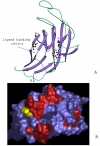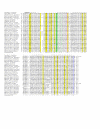Application of comparative genomics in the identification and analysis of novel families of membrane-associated receptors in bacteria
- PMID: 12914674
- PMCID: PMC212514
- DOI: 10.1186/1471-2164-4-34
Application of comparative genomics in the identification and analysis of novel families of membrane-associated receptors in bacteria
Abstract
Background: A great diversity of multi-pass membrane receptors, typically with 7 transmembrane (TM) helices, is observed in the eukaryote crown group. So far, they are relatively rare in the prokaryotes, and are restricted to the well-characterized sensory rhodopsins of various phototropic prokaryotes.
Results: Utilizing the currently available wealth of prokaryotic genomic sequences, we set up a computational screen to identify putative 7 (TM) and other multi-pass membrane receptors in prokaryotes. As a result of this procedure we were able to recover two widespread families of 7 TM receptors in bacteria that are distantly related to the eukaryotic 7 TM receptors and prokaryotic rhodopsins. Using sequence profile analysis, we were able to establish that the first members of these receptor families contain one of two distinct N-terminal extracellular globular domains, which are predicted to bind ligands such as carbohydrates. In their intracellular portions they contain fusions to a variety of signaling domains, which suggest that they are likely to transduce signals via cyclic AMP, cyclic diguanylate, histidine phosphorylation, dephosphorylation, and through direct interactions with DNA. The second family of bacterial 7 TM receptors possesses an alpha-helical extracellular domain, and is predicted to transduce a signal via an intracellular HD hydrolase domain. Based on comparative analysis of gene neighborhoods, this receptor is predicted to function as a regulator of the diacylglycerol-kinase-dependent glycerolipid pathway. Additionally, our procedure also recovered other types of putative prokaryotic multi-pass membrane associated receptor domains. Of these, we characterized two widespread, evolutionarily mobile multi-TM domains that are fused to a variety of C-terminal intracellular signaling domains. One of these typified by the Gram-positive LytS protein is predicted to be a potential sensor of murein derivatives, whereas the other one typified by the Escherichia coli UhpB protein is predicted to function as sensor of conformational changes occurring in associated membrane proteins
Conclusions: We present evidence for considerable variety in the types of uncharacterized surface receptors in bacteria, and reconstruct the evolutionary processes that model their diversity. The identification of novel receptor families in prokaryotes is likely to aid in the experimental analysis of signal transduction and environmental responses of several bacteria, including pathogens such as Leptospira, Treponema, Corynebacterium, Coxiella, Bacillus anthracis and Cytophaga.
Figures










References
-
- Alberts B, Bray D, Lewis J, Raff M, Roberts K, Watson JD. In Molecular Biology of the Cell. Garland Publishing, Inc; 1999.
-
- Lodish H, Berk A, Zipursky SL, Matsudaira P, Baltimore D, Darnell J, Zipursky L. In Molecular Cell Biology. WH Freeman & Co; 1999.
-
- Koretke KK, Lupas AN, Warren PV, Rosenberg M, Brown JR. Evolution of two-component signal transduction. Mol Biol Evol. 2000;17:1956–1970. - PubMed
Publication types
MeSH terms
Substances
LinkOut - more resources
Full Text Sources
Other Literature Sources
Molecular Biology Databases
Research Materials

